The term megabreccia is used when we are dealing with very extensive breccias and large clasts. In fact, large parts of the Rubielos de la Cérida impact basin and especially of the central uplift chain, exhibit megabreccias. Below, we show various aspects of these megabreccias. Their location with respect to the general contours of the Rubielos de la Cérida elongated impact basin is in each case shown on small topographical images.
The Barrachina megabreccia (northern basin)
In the environs of Barrachina (roughly between the villages of Navarrete and Torre los Negros), the impact-related rocks are exposed over several kilometers. The megabreccia is deposited in contact with bedded sediments which are, however, strongly folded and faulted. We suggest that these contact zone reflects the crater floor. The overall thickness of the breccia and its components may reach up to 50 m. Within the megabreccia, various kinds of impact melt rocks and suevites have been found (see Impact melts).
Opponents of the Azuara/Rubielos de la Cérida impacts (M. Aurell, E. Díaz-Martínez, A. L. Cortés, from the Zaragoza university and the Astrobiological Center in Madrid, and others) consider the peculiar megabreccia deposits to be the result of collapse by the dissolution of gypsum. We do not want to further comment their explanation here. The visitors of our website may draw their own conclusions.
 Figs. 1, 2. Temporarily exposed megabreccia in a former quarry near Barrachina: a diamictic mixture of Paleozoic and Lower Tertiary materials.
Figs. 1, 2. Temporarily exposed megabreccia in a former quarry near Barrachina: a diamictic mixture of Paleozoic and Lower Tertiary materials.
 Fig. 2.
Fig. 2.

 Fig. 3. Megaclast exhibiting completely disintegrated bedding.
Fig. 3. Megaclast exhibiting completely disintegrated bedding.
 Fig. 4. Multicolored breccia as part of the Barrachina megabreccia: an intense mixture of diamictic, mostly Paleozoic material and ?Tertiary red and green marls (temporary quarry). – Grit-brecciated limestone megaclast are partly interspersed with a marly to sandy matrix.
Fig. 4. Multicolored breccia as part of the Barrachina megabreccia: an intense mixture of diamictic, mostly Paleozoic material and ?Tertiary red and green marls (temporary quarry). – Grit-brecciated limestone megaclast are partly interspersed with a marly to sandy matrix.
 Fig. 5. A few larger clasts have survived the heavy brecciation, and some preserved ghost layering is observed (between the Cutanda junction and Barrachina).
Fig. 5. A few larger clasts have survived the heavy brecciation, and some preserved ghost layering is observed (between the Cutanda junction and Barrachina).
 Figs. 6, 7. Excavation/emplacement in the impact cratering process: a complex superposition of flow, faulting and overthrusting of intermixing diamictic and sandy material.
Figs. 6, 7. Excavation/emplacement in the impact cratering process: a complex superposition of flow, faulting and overthrusting of intermixing diamictic and sandy material.
 Fig. 7.
Fig. 7.

 Fig. 8. Diamictites (d) having excavated a megaclast (mc) of Lower Tertiary marls and gypsum – a phenomenon actually opposing collapse by dissolution.
Fig. 8. Diamictites (d) having excavated a megaclast (mc) of Lower Tertiary marls and gypsum – a phenomenon actually opposing collapse by dissolution.
 Fig. 9. Megaclasts of different lithology in contact. A microbreccia (whitish color) seems to have been injected into the middle, diamictic clast.
Fig. 9. Megaclasts of different lithology in contact. A microbreccia (whitish color) seems to have been injected into the middle, diamictic clast.
 Fig. 10. Barrachina Megabreccia: Diamictic megaclast flanked by strongly fractured Lower Tertiary (?) limestones.
Fig. 10. Barrachina Megabreccia: Diamictic megaclast flanked by strongly fractured Lower Tertiary (?) limestones.
 Fig. 11. Diamictic material tunneling into bedded marls (arrow). Near Navarrete.
Fig. 11. Diamictic material tunneling into bedded marls (arrow). Near Navarrete.
 Fig. 12. Prominent fault plane in the megabreccia zone proving horizontal displacement (near Navarrete).
Fig. 12. Prominent fault plane in the megabreccia zone proving horizontal displacement (near Navarrete).

 Fig. 13. This peculiar fold is exposed near the village of Barrachina. The fold is portrayed by a competent, however heavily brecciated Lower Tertiary limestone layer. The core of the fold is a pulp of nearly pulverized carbonate rock without any regular internal structure. Only a few limestone fragments are preserved.
Fig. 13. This peculiar fold is exposed near the village of Barrachina. The fold is portrayed by a competent, however heavily brecciated Lower Tertiary limestone layer. The core of the fold is a pulp of nearly pulverized carbonate rock without any regular internal structure. Only a few limestone fragments are preserved.
Megabreccia near Corbatón (northeast basin)
The megabreccia comprises extensive in situ brecciated rocks, mostly Jurassic limestones and Lower Tertiary conglomerates, and polymictic allochthonous megaclasts.

 Fig. 14. Diamictic megaclast in the megabreccia near Corbatón west of Rubielos de la Cérida.
Fig. 14. Diamictic megaclast in the megabreccia near Corbatón west of Rubielos de la Cérida.
 Fig. 15. Megabreccia near Corbatón. Three breccia generations.
Fig. 15. Megabreccia near Corbatón. Three breccia generations.
Megabreccias near Bueña (central-uplift chain)

 Fig. 16. Megabreccia near Bueña. Criss-cross layering of Jurassic limestones in the central uplift chain.
Fig. 16. Megabreccia near Bueña. Criss-cross layering of Jurassic limestones in the central uplift chain.

 Fig. 17. Megabreccia between Argente and Bueña. Megaclasts in contact: diamictite containing plastically deformed limestone components, and well bedded, steeply dipping Malmian limestone.
Fig. 17. Megabreccia between Argente and Bueña. Megaclasts in contact: diamictite containing plastically deformed limestone components, and well bedded, steeply dipping Malmian limestone.
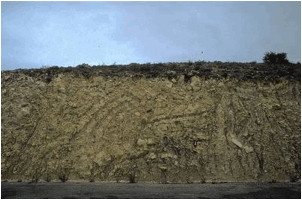
 Figs. 18/19. Megabrecciation of Jurassic limestones in the central-uplift chain (between Bueña and Caminreal). Note that only some “ghost” layering has survived the intense brecciation.
Figs. 18/19. Megabrecciation of Jurassic limestones in the central-uplift chain (between Bueña and Caminreal). Note that only some “ghost” layering has survived the intense brecciation.
 Fig. 19.
Fig. 19.
Megabreccia between Alfambra and Escorihuela (eastern basin)

 Fig. 20. Multicoloured breccia composed of ?Lower Tertiary megaclasts.
Fig. 20. Multicoloured breccia composed of ?Lower Tertiary megaclasts.
Megabreccia between Escorihuela and El Pobo (southeastern rim)
The new road construction between Escorihuela and El Pobo/Corbalán has exposed 1.5 km breathtaking megabreccia outcrops at the basin rim. The megabrecciation comprises Buntsandstein, Muschelkalk and Buntsandstein-Muschelkalk transitional layers (the Muschelkalk being erroneously mapped as Rhaetian-Liassic on the official geological map). Because parts of the outcrop scenario will probably be disguised soon by weathering, we have continuously recorded the fresh wall on digital video (of about ten minute duration). For interested visitors of our website, a copy on CD is available.

 Fig. 21. Large irregular scour faces, exhibiting striations and polish, within the megabreccia.
Fig. 21. Large irregular scour faces, exhibiting striations and polish, within the megabreccia.
 Fig. 22. Complex superposition of flow, folding, faulting and thrusting (also see images below).
Fig. 22. Complex superposition of flow, folding, faulting and thrusting (also see images below).
 Fig. 23.
Fig. 23.
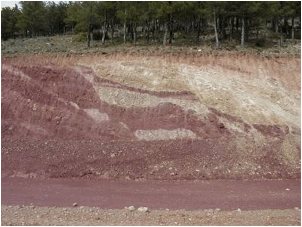 Fig. 24.
Fig. 24.
 Fig. 25.
Fig. 25.
 Fig. 26.
Fig. 26.
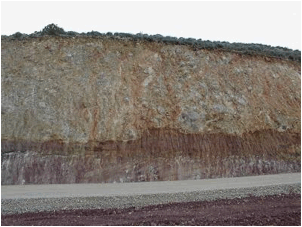 Fig. 27.
Fig. 27.
 Fig. 28. Tunneling and injected large clasts.
Fig. 28. Tunneling and injected large clasts.
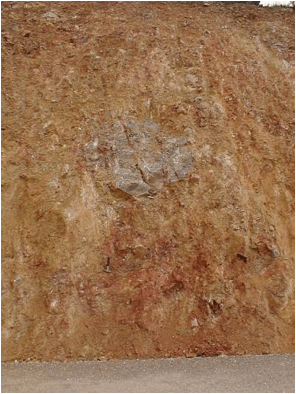 Fig. 29.
Fig. 29.
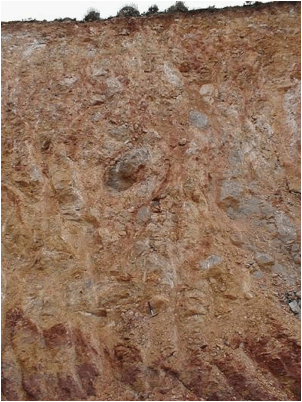
 Figs. 30-32. Rotated texture.
Figs. 30-32. Rotated texture.
 Fig. 31.
Fig. 31.
 Fig. 32. Rotated texture.
Fig. 32. Rotated texture.
Megabreccia between Cedrillas and Teruel (southeastern rim zone)

 Fig. 33. Extensive megabrecciation of Muschelkalk limestones with irregularly oriented scour faces exhibiting prominent slickensides and polish.
Fig. 33. Extensive megabrecciation of Muschelkalk limestones with irregularly oriented scour faces exhibiting prominent slickensides and polish.
Megabreccia northeast of Caudé (southern central-uplift chain)

 Fig. 34. Polished scour face within megabreccia of the central-uplift chain.
Fig. 34. Polished scour face within megabreccia of the central-uplift chain.








































































 Fig. 35. Megabrecciation of well-bedded Jurassic limestones in the central-uplift chain. Note the hummocky landscape typical of the megabrecciation. In the background: the eastern basin rim.
Fig. 35. Megabrecciation of well-bedded Jurassic limestones in the central-uplift chain. Note the hummocky landscape typical of the megabrecciation. In the background: the eastern basin rim.